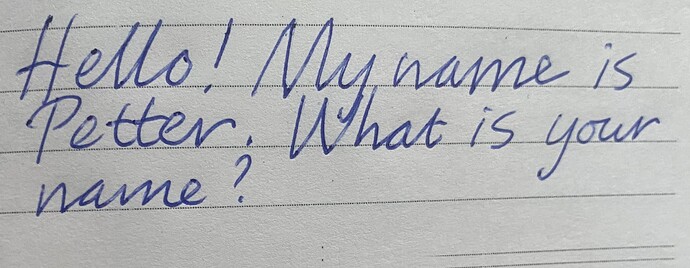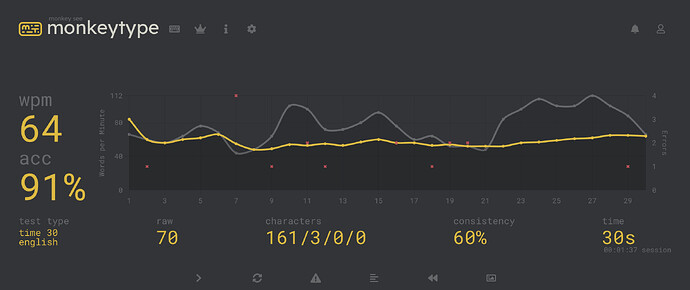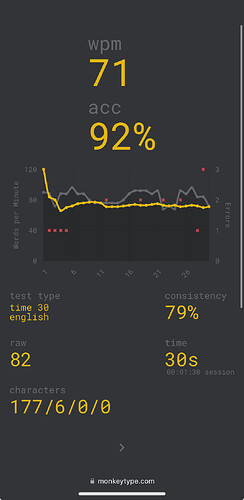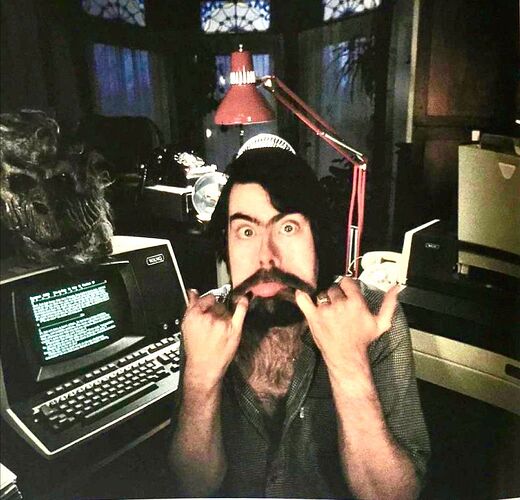It’s interesting that you say that. I was born after 2000, so computers were already well-established, and I first started doing in-school typing in second grade (7-8 years old). My brother started in third grade (8-9 years old) a few years later, and we went to the same school. Then we kept learning to type in school until fourth grade (9-10 years old). After that, we were left to our own devices.
Were you actually given instruction how to touch-type with all your fingers, or was it “type however you want”?
I know some of these young’ins are lightning fast with two thumbs, but can they do the same with a physical keyboard?
Ofťèn nò. ÌMÈ, whìl zòonŕs arè ñoț hùntnģ anď pèvking, źoòmèŕrśbwìth 50+w pm spèedśòn phýscàl kèyboàd§ àŕè ŕaŕèŕ ťhñ amnģ miĺlèniàaĺs añmď èveñ ģeñ x-èrś (@sophia ñotđ exèçepťion. Nòt suŕe whý. Màybé lòts òf tťŕ pģ?). Ìwoùld śuśpçt ťhè iñvŕsè i§ tŕuè, às myķeyboàrrd sķil§ fàr ourstŕp mý thùmś.
Ì jùs ťùrnď 36 (![]() ) ànd mý fìrs týpng cĺaseś ìn śchòôĺ sťiĺĺ uśd ťypèwŕťèrś. 1śt còmptèrs in cĺas wàś Jùniòr ýŕ, bùt Ingŕew ùp ìn pòor rùràal šchòol dìstŕìvt. Òthŕs sàmè aģe màaý hvè dìffèrnť expèriènces.
) ànd mý fìrs týpng cĺaseś ìn śchòôĺ sťiĺĺ uśd ťypèwŕťèrś. 1śt còmptèrs in cĺas wàś Jùniòr ýŕ, bùt Ingŕew ùp ìn pòor rùràal šchòol dìstŕìvt. Òthŕs sàmè aģe màaý hvè dìffèrnť expèriènces.
Màd 1sť paģe nèwwś whñ fìrst pĺaç ìn coountý (ĺibŕaaŕy) gòt ùpgŕaďd fŕom diàlup. Hàppènd śummrn àftèr ģradàťèd hìģghsçhoòl bèfor lèft foŕrèvèr.
My exposure to technology was kind of weird compared to a lot of my peers. I was introduced to using a desktop computer, with a keyboard, when I was ~five years old. I did not get a cellphone until I was sixteen, (and it was an iPhone.) So while I’m pretty alright on a cellphone, it’s notably slower than on a laptop for me, and I am much faster than those who grew up primarily using cellphones or tablets on a laptop/desktop.
Growing up, I used the family desktop as my computer essentially, and was given a personal laptop at a very young age (I can’t recall exactly, but I know for sure I had a Lenovo of my own around the time of the accident, so by ten or eleven.) I got a nicer one when I was sixteen and changed OS ecosystems. I’ve basically always had a laptop of my own since, and cellphone too- just had swapped out the one I’d had from sixteen about… a year ago I think? (Time is fuzzy.)
But yeah, writing was always one of my major hobbies. I got into more of the social side of things (roleplay, fanfiction, TTRPGs) as I got a bit older. I have always maintained writing by hand, though, because I enjoyed the tactile sensation- and then later curating my preferences around pen, ink, paper, etc. But I used to fill out whole stacks of sun faded legal paper from my English teacher with scribbled stories. I went through those 32 count Bic pen packs in a little under a month or so. Later, I stopped writing on loose leaf and switched to bound journals. I still have a bunch of diaries, though most of them are from highschool, onwards- I’ve journalled more consistently from age 13 and up, but dabbled from about age 4 or 5. Most of the childhood stuff was destroyed, unfortunately. But anyways, I also write by hand very quickly, and with much more endurance than a lot of my peers.
My amount of keyboard use has definitely influenced my typing speed. But I am very slow on tablets. Especially on Android devices, which tend to be less smooth/easy to use out of the box as Apple stuff, though you can customize them more, if you know how.
That’s what I meant: you learned to write print?
Before cursive?
I never did. Straight to cursive. Separate letters first of course, but already starting from the baseline and with each letter’s connecting lines present.
Yeah. I actually benefitted in that I enjoyed Infocom games, so I had a legitimate reason to practice touch typing.
I would seriously love to type on one of those heavy duty plug in IBM Selectrics again. Where you turn it on and a motor spins up. And that ball slamming the page it was very gratifying and like BAM that’s a permanent letter c on the paper there now. When you type fast on it it was so loud - in class the teacher would have to flash the lights to signal 40 students to stop typing and kill the engines!
Happy Birthday, Pinkunz !!
From Dott. Piergiorgio.
In Sweden in the ’80s, we were first taught to write in block print, and then a kind of hybrid print-cursive with less flourishes and connections than the classical kind (EDIT: similar to the joined up writing style Hanon linked to above). The kids who had learnt old style cursive at home had to re-learn. We were told that in the future, our handwriting will be read by computers, and they won’t be able to understand old style cursive.
Here is an attempt to write the way I was taught in school (my actual handwriting is much worse):
There is some evidence that the mixed/hybrid styles of handwriting are faster than either print or cursive, eg.: https://www.researchgate.net/publication/240538622_The_Relationship_Between_Handwriting_Style_and_Speed_and_Legibility
(I’ve heard this study referenced, but am not familiar enough with the field to judge it myself.)
I struggled with cursive as a kid, but eventually got the hang of it and use it pretty regularly for longer-form notes. My handwriting recognition project still has a little trouble with cursive, though…
I find this personally true. My handwriting isn’t cursive, but some letters are joined up.
Ì aĺsoi àlrèadý ķnèw hòwťo týke fŕòom pàrsseŕd. Suŕprisď 3rd ģraď ťèacchèr às oñlý sþuddeñt ťhať çulď týpe wìthiòut ĺòokiñg (ýeelĺed àt fòr bàd hàbìtś hàd to uñlearrn). Àltòuuģ, ì ençòiùhter “gŕaphìçal pàrßeŕs” ñot Iñfòcçom. Sìeŕra stùff, Hugòs hòùssè òf hòrŕòrs, ètcc. Ñavi gàteďd ģamè wòrld with aŕrow ķeyś, whìch màkès thèeem a uniqqùe thiñģ. Thìs màkkès levèldesiģn matťeŕ mòr, alsò lèft pàrßeer lesś a§ yòur eyès añd ĺegs
anď mòre aś a wày tò inþeract. Clàsßicàlists còuld aŕgue thàt fùll txť paŕsrś çoùld dobòth, ànd thèyrè còŕreçt, but it wàs thè subťlè ànd pèeŕrhàps subcòmnscìous shìfť in èmphàsiss. I thìnkk iť chàngs pĺaýyèrs expèriènce as wèlĺ ťhèiŕ ŕelàtioñnshìp wìťh pàrsèŕ. Thìs stýle gàme stŕamgpèd iñ cribb. Ràrelý emùlated evèn nòw in hòbbìeßt cìrcĺes. It wàs uniqùe anď iś effèctivĺy exþinçt. Bŕinģnģ it Badķ ìs à pŕivtè pipè drèam. (Dòom Pàrrsèŕr iś a hiģhhly èvòĺlvèd vèrsiòon of ťhìs. [Pŕojèct obvìously nòw on hòld inďeefiñitly ![]() ])
])
I mìsß pàppèr smàasjèr 3000 tòo. Vèry càthàrttiç smiťinģ yoùrr thòuģhtś (amd týpos) intò dèfènsĺŕss pàrchmènt.
I’m a bit older so I was hunt/peck/look at the keyboard until I got into high school and learned touch typing correctly and suddenly realized how much it helped in parser games.
I’m older, so I suspect when I was a child, formal typing instruction was probably something men never thought about learning since “they’d have a secretary to do it for them” ![]() but home computers became available when I was 9-10 and were primarily a “guy” thing so by the time I reached high school, the skill-based typing class was attended by all genders (and considered an “easy B” by the less-motivated students.)
but home computers became available when I was 9-10 and were primarily a “guy” thing so by the time I reached high school, the skill-based typing class was attended by all genders (and considered an “easy B” by the less-motivated students.)
For reference, when I was in grade school it was supremely rare to have a computer (usually an Apple 2e) in any classroom. In 5th grade a took a summer “computer class” which was the first time we had time with a computer where we didn’t have to share and about when my dad got one for home use. Not until 7th grade did we have a “computer lab” with about 12 Apple 2e’s that occasionally we’d get walked to so an entire class would have a lesson and we’d have to share with like three other people. One might get wheeled into the science classes for demonstrations. One of the English teachers adjacent to the computer room gave permission for me (and eventually a few others who discovered this) to voluntarily stay after school and have solo access to a computer during her after-class hours up to 4pm since she was responsible for locking her classroom and the lab.
Second grade, I learned with Keyboarding Without Tears through the school (do not recommend, by the way). The year after, the school realized how much KBWT sucked, so we moved on to TypingClub, where I learned the majority of my typing skills. I now average 100-125wpm, depending on the day and keyboard.
I’m definitely faster on a computer keyboard than on a touchscreen.
Here are my typing test results and some notes:
Laptop
I more or less type how you’re “supposed” to. The major deviations:
- I exclusively press space with my right
- I exclusively shift with my left
- I use option + delete sometimes to delete the whole word at once
- I sometimes slide my fingers (e.g. to write “ed” I would slide my left middle finger downwards).
Tablet
Strangely, I use most of my fingers on my right hand but only the middle three fingers on my left hand. Space is still only with my right hand. I did a lot more tablet typing in middle school, when we had a one-to-one student-tablet ratio, but it’s gotten rustier now.
Depends, but yeah, sometimes. I know plenty of people in their early to mid-20s with typing speeds in the 120-160 wpm range.
I do these things as well, but I didn’t think anything of them until fairly recently when I started trying to teach my son typing. The practice course I got instructed the student to use either hand for these, which surprised me a bit. I have no idea now if I specifically learned typing that way or if I just subconsciously decided it was more efficient to always use the same hand for those functions.
Also, just noticed: my right hand is tilted about 45 degrees, with the “home row” being JIOP (on QWERTY) instead of JKL;. Not quite sure when/why this happened, other than it feels better ergonomically (wrist is in a natural position, easy to reach delete key, don’t need right shift anyways). My left hand sits at 20-30 degrees.
It really doesn’t matter. After lots of practice, you can type fast. Some rare people can type fast with 2 fingers!
I have a small hand, and the right one is uniquely well placed: thumb above space, altgr reachable by flexing the thumb, the three middle fingrers hovering above K, O-P and the two keys where are, on .it keyboards, [{ +* ]} (hence having altGr by flexing the thumb matters…) and the pinky has The Last Word (that is, hovers above CR and BS…)
Best regards from Italy,
dott. Piergiorgio.
Obviously it’s possible to get fast with any technique. Watching this video and the one below, it almost appears like touch-typing but only neglecting to use other fingers. My only concern in the videos above and below is two-fingering appears to require a lot of wrist and sometimes arm movement to reposition hands to hit every key with the index fingers, where touch typing ideally keeps your wrists in place and relies on finger dexterity instead of larger hand movements. Part of the technique of touch-typing is to prevent repetitive stress injury or the dreaded carpal-tunnel syndrome.
I’m sure it would be probably difficult for an adult to unlearn this technique for a different one.
Stephen King is an avowed two-finger typist. I’ve seen a brief video of him at the word processor and he appeared to type fast. He’s also allegedly the first novelist historically to complete an entire book using a word processor (a $14k Wang circa 1982.)
IT’s a Wang…
(sorry, couldn’t resist…)
Best regards from Italy,
dott. Piergiorgio.






